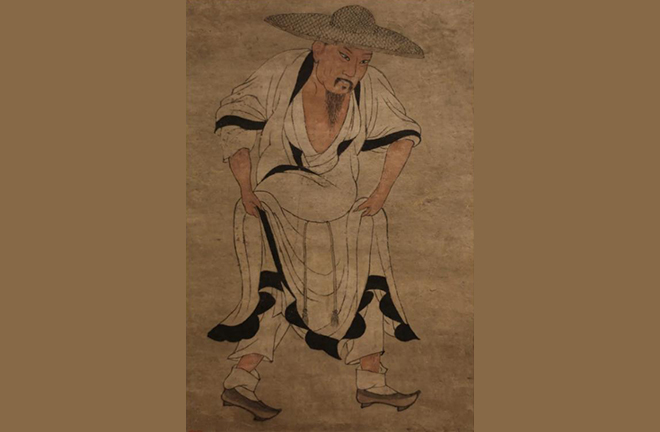Image of Su Shi reconstructed from historical paintings

FILE PHOTO: Part of Ming Dynasty painter Zhu Zhifan’s copy of Song Dynasty painter Li Gonglin’s “Dongpo Liji Tu” [Su Dongpo in a Bamboo Hat and Clogs]
In mid-May, an academic symposium took place in Chengdu, Sichuan Province, focusing on the historical artworks featuring the trio known as the “Three Sus”—Su Shi, also recognized as Su Dongpo, alongside his father Su Xun, and his younger brother Su Zhe, who were renowned literary figures during the Northern Song Dynasty (960–1127).
Image of paintings
Compared to literati of past dynasties, Su Shi may have been the subject of the most extant portraits. Depictions of him mainly focus on the “Dongpo Liji Tu” [Su Dongpo in a Bamboo Hat and Clogs], “Chibi Tu” [Su Shi Visiting the Red Cliff], and “Xiyuan Yaji Tu” [The Elegant Gathering in the West Garden] paintings, upon which many subsequent works were based
Zhu Wanzhang, a research librarian at the National Museum of China, noted that the collections of Su Shi portraits can be categorized into two types: bust portraits and full-body portraits. Additionally, Su Shi’s likenesses can be found in certain anthologies, block prints, and inscriptions, most of which are line drawings. These portraits are chiefly facsimiles of Song (960–1279) and Yuan (1271–1368) paintings, retaining Su Shi’s distinctive features such as the “Dongpo kerchief” or a bamboo hat, a dark mole on his right cheek, a sparse beard, a refined appearance, and medium height. Beyond standalone portraits, smaller likenesses of him can be seen in paintings like “Xiyuan Yaji Tu,” “Dongpo Liji Tu,” “Chibi Tu,” and “Meishan Hanmo Tu” [A Cultural Activity of Su Shi’s Family]. Most standalone portraits have reliable and traceable origins. According to Zhu, the evolution of Su Shi’s image illustrates the spread and influence of Su Shi and his art among later generations.
In the view of Pan Shuxian, a professor from the School of Literature and Journalism at Xihua University, the construction of Su Shi’s image was a dynamic and ongoing process. The perceived image of Su Shi bears little resemblance to the actual person, implying the interplay between literary classics and artistic classics, cultural celebrities and celebrity culture. The intriguing development of Su Shi’s image mirrors his perpetual artistic charm.
Pan further noted that “Xiyuan Yaji Tu” has consistently enjoyed popularity and continuous reproduction across various artistic mediums such as painting, poetry, and sculpture. This “elegant gathering” depicts an art salon integrating literature, calligraphy, painting, zither-playing, Buddhist and Taoist philosophical discussions, chess-playing, and tea-tasting, typifying the poetic lifestyles of the literati of the Northern Song Dynasty.
The scene in “the West Garden gathering” took place during the Yuanyou period of the Northern Song Dynasty. Chen Shan, deputy dean of the College of Fashion and Design Art at Sichuan Normal University (SICNU), researched the picture from a visual perspective. The organization and depiction of garden gathering activities after the Song Dynasty was influenced by the model of the West Garden gathering. It became commonplace for literati and monks to tour the garden together, engaging in philosophical exchanges. Zither, chess, calligraphy, and painting were among the most integral aspects of these garden gatherings. Appreciating antiques, watching dramas, and interpreting Confucian classics were also commonplace. These activities further enriched the emotional expression and poetic lives of the literati.
According to Su Shi’s own accounts, portraits were painted for him by individuals such as the scholar He Chong, the monk Miaoshan, the Taoist Li Derou, painters Cheng Huaili and Li Gonglin, among others. Unfortunately, none of these paintings survived to the present day. Huang Bo, an associate professor from the School of History and Culture at Sichuan University, believes that the imagery within the paintings demonstrates the literati’s yearning for nature and freedom, as well as their quiet cultural tastes.
Multiple research dimensions
Painter Shitao (1642–1708) tried to compete with the poetry of Su Shi, with the intention of elevating paintings to a status on par with poetry, said Chen Linlin, a lecturer from the School of Arts at Renmin University of China. By invoking and creatively presenting Su Shi’s poems, Shitao endows his paintings with the style and essence of poetry.
Urban memorial spaces in ancient China refer to buildings or sites within urban public areas that serve commemorative functions or host memorial activities. During the Daoguang period of the Qing Dynasty (1644–1911), a new Su Shi temple was built next to the Dinghui Temple in Suzhou City, Jiangsu Province, serving as a special memorial space displaying drawings of Su Shi. Cheng Yin, an associate research fellow from the Three Sus Research Institute at SICNU, explained that the memorial space of the Su Shi Temple was built based on three factors: temples, scholars, and art and literary activities.
Wang Yi’nan, an associate research fellow at the Chinese National Academy of Arts, suggested that the “narrative in circular space” image mode reconstructs the spatial logic of the original text by repositioning mountains and water, relying on the viewer’s imagination to restore the progression of the plot with temporal logic. The visual transformation of the spatio-temporal relationship then presents multiple scenes as desolate and uninhabited, creating an atmosphere of ethereal tranquility.
In Wang’s view, the depiction of the literati’s leisure activities in contemporary paintings, such as in “Su Shi Visiting the Red Cliff,” is closely related to the portrayal of literati outings during the same period. Through the depiction of the visit of the Red Cliff, the historical existence of Su Shi is confirmed in a more straightforward way.
The salon was sponsored by the Three Sus Research Institute at SICNU, and co-organized by the Meishan San Su Shrine Museum and the College of Fashion and Design Art at SICNU.
Edited by YANG LANLAN
